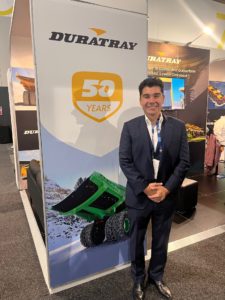Duratray International has taken its business to a new level in Australia with a state of the art factory that has more than doubled its suspended dump body (SDB) capacity. It represents the culmination of many years of activity in the country since its parent, Chile’s Conymet International Group, bought Duratray and its world renowned suspended dump bodies from Pacific Dunlop in 2001, which included its Australian operations, Duratray International Pty Ltd.
Marcelo Medel, Duratray Managing Director, told IM recently at the IMARC show in Sydney: “We have had an existing workshop in Bayswater, an eastern suburb of Melbourne, since we purchased Duratray over 20 years ago. We had been looking to expand for some time – to more than double the size of the factory to meet market demand and thereby double our revenue, but the existing site was aging and did not have the latest technology in place. So three years ago we decided to go with a state of the art, greenfield location tailored to our needs with all the latest equipment.”
IM Editorial Director, Paul Moore, met with Duratray Managing Director Marcelo Medel at IMARC 2023 in Sydney

Medel continued: “The fact that our capacity was limited with rising demand also meant our delivery times were getting longer so we had to take this major step. We designed and built a 10,000 m2 facility in in the southeast part of Melbourne, in Pakenham. This was a huge investment for us of A$15 million, in fact the biggest international investment we have made since the original purchase.”
The location made sense in several ways – first of all, still being in the Melbourne urban area, most of the Duratray experienced people didn’t need to move. Medel says Duratray did look in Queensland as a lot of its major customers are there, such as the Bowen Basin and Galilee Basin coal mines, which includes the bodies on the Caterpillar 796 AC fleet at Bravus Mining’s Carmichael operation.
But support from the Victoria Government, including financial assistance from INVEST Victoria, made a big difference. And it wasn’t just financial support. Medel recently told INVEST Victoria in an interview: “Victoria is well-known for having a highly skilled workforce, and we acknowledge our human resources as our main and most valued asset. Moreover, Victoria provides great support to innovation and research and development projects, which is essential for us into the expansion to mining data analytics, industry 4.0 and our Carbon Fibre branch. Throughout the process, we have been supported by different entities within Victoria, not only financially, but also in terms of advice and guidance on the best way to approach the project. We also considered Victoria, as it is an internationally recognised hub for imports and exports activity. The state’s logistics and distribution networks are key for our supply chain, successful delivery of our products and satisfactory service to our customers.”
The new factory has an all new autoclave, a core part of the SDB production process. Medel comments: “Our process is fully patented and that is one of the reasons why we are the only company globally to offer SDBs. Only we can make a rubber mat of this kind that measures in excess of 10 m by 10 m and 150 mm thickness from handrail to handrail. We put the rubber on top of huge frames and after a few of these layers we wrap them up and then put the mat into the autoclave – which is one of only two this size in the Southern Hemisphere, the other being the original Conymet autoclave in Chile.” To make the complete SDB, the final mat is suspended on top of suspended elastomeric ropes that are anchored to the steel frame of the truck’s body.
The Australian market demands unique levels of quality and Duratray has been able to take advantage of all of its learnings from the Bayswater plant over the years in the new facility and production line. The size of the new plant also means there is added space for its new projects like the mentioned Carbon Fibre branch – where Duratray is developing carbon fibre mining truck bodies – and is working with Deakin University on the project. Medel: “There have been challenges, such as developing the right resin to be able to paste steel lines to the carbon fibre structure but we are working through those and we are expecting to trial a prototype body in Sweden by mid-2024.”











